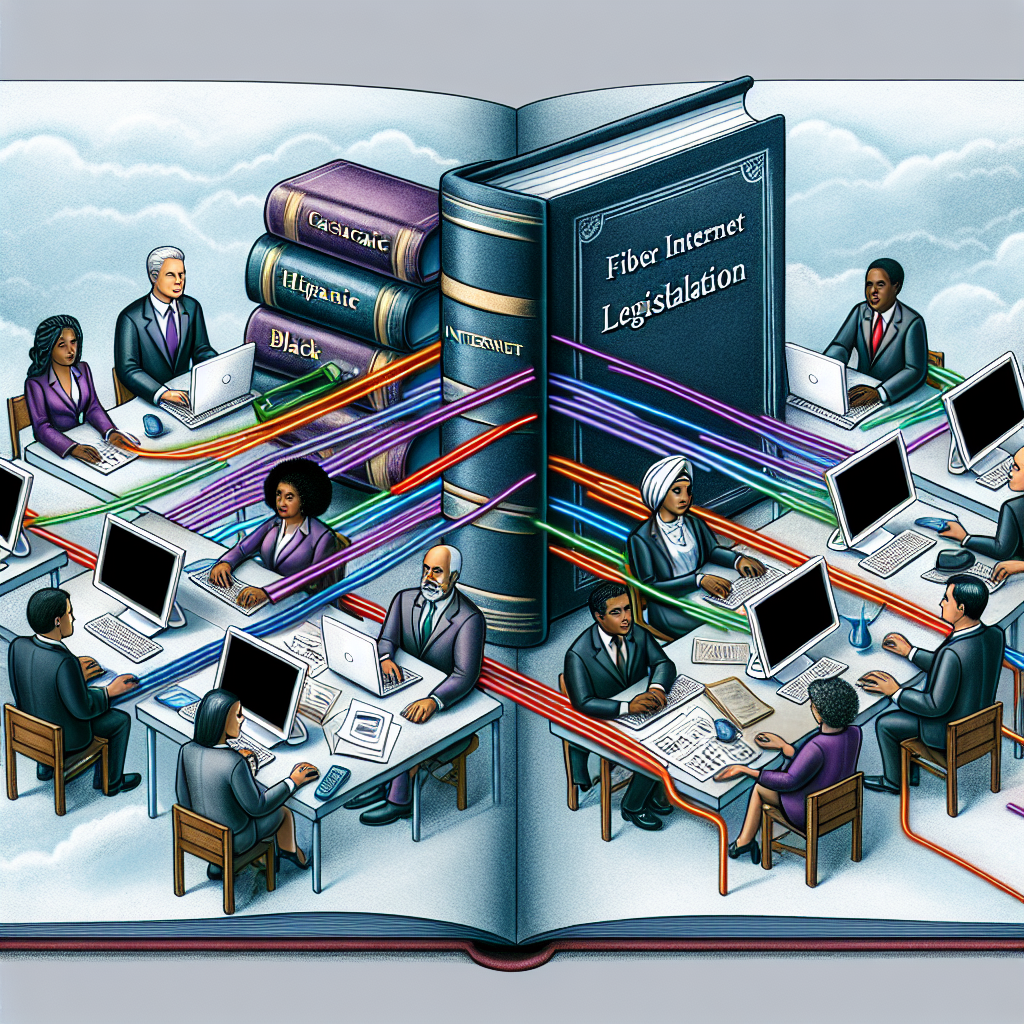In today’s rapidly evolving digital landscape, access to high-speed internet is no longer a luxury but a necessity. As governments around the world strive to bridge the digital divide, efforts are being made to promote digital inclusion through the implementation of fiber internet legislation. By investing in infrastructure that supports high-speed internet connectivity, policymakers aim to provide equal opportunities for all individuals to participate in the digital economy and access essential services. Join us as we explore the impact of fiber internet legislation on digital inclusion efforts, and the implications it has for building a more connected and inclusive society.
Understanding Digital Inclusion
Defining Digital Inclusion
Digital inclusion refers to the equitable access and use of digital technologies, such as the internet, by all individuals in society. It encompasses not only the availability of internet infrastructure but also the affordability of services, digital literacy, and the ability to make use of online resources effectively. In essence, digital inclusion aims to bridge the digital divide and ensure that everyone has the opportunity to participate fully in the digital world.
Importance of Digital Inclusion in Today’s Society
In today’s increasingly digitalized society, access to the internet is crucial for various aspects of daily life, including education, employment, healthcare, communication, and civic engagement. Digital inclusion is essential for ensuring equal opportunities for all individuals, regardless of their socio-economic background or geographical location. Without digital inclusion, marginalized communities risk being left behind, further exacerbating existing inequalities. By promoting digital inclusion through initiatives such as fiber internet legislation, policymakers can help create a more inclusive and equitable society where everyone has the chance to thrive in the digital age.
Significance of Fiber Internet Legislation

Overview of Fiber Internet Legislation
Fiber internet legislation plays a crucial role in shaping the digital landscape of a nation. It involves laws and regulations that govern the deployment, expansion, and maintenance of fiber optic networks to facilitate high-speed internet access. These legislations are designed to incentivize investment in fiber infrastructure and promote competition among internet service providers. By establishing guidelines for the deployment of fiber networks, governments can ensure that citizens have access to reliable and fast internet connectivity.
Impact of Fiber Internet on Digital Inclusion Efforts
The significance of fiber internet legislation lies in its ability to enhance digital inclusion efforts. Fiber optic technology offers unparalleled speed and reliability, making it a key enabler of digital equity. By ensuring widespread access to fiber internet through legislative measures, policymakers can bridge the digital divide and provide underserved communities with the tools they need to participate fully in the digital economy. Additionally, fiber internet can empower marginalized populations by providing them with access to critical online services, educational resources, and job opportunities. In this way, fiber internet legislation plays a vital role in promoting social and economic inclusion for all citizens.
Challenges in Achieving Digital Inclusion
Accessibility Barriers to Broadband Internet
-
Rural Areas: One of the primary challenges in achieving digital inclusion is the lack of access to broadband internet in rural areas. The infrastructure required to provide high-speed internet services often does not reach remote regions, leaving residents with limited connectivity options.
-
Cost: Another significant barrier is the cost associated with broadband internet services. Many low-income individuals and families struggle to afford the monthly fees required for a reliable internet connection, further widening the digital divide.
-
Digital Literacy: Even in areas where broadband internet is available, there may still be challenges related to digital literacy. Some individuals may lack the skills and knowledge needed to effectively use the internet for educational, professional, or personal purposes.
Socioeconomic Factors Affecting Digital Inclusion
-
Income Disparities: Socioeconomic factors play a crucial role in determining who has access to reliable internet services. Individuals from lower-income households are less likely to have access to broadband internet, putting them at a disadvantage in terms of educational and economic opportunities.
-
Education Levels: Education levels also impact digital inclusion efforts. Individuals with higher levels of education are more likely to have the skills and resources needed to navigate the digital landscape effectively, while those with lower levels of education may struggle to keep pace with technological advancements.
-
Urban vs. Rural Disparities: Disparities between urban and rural areas further complicate efforts to achieve digital inclusion. Urban centers often have better access to high-speed internet services and resources, while rural communities are left behind due to limited infrastructure and investment in broadband technology.

Role of Government in Promoting Digital Inclusion
In promoting digital inclusion, governments play a crucial role through various initiatives and programs aimed at bridging the digital divide and ensuring equitable access to high-speed internet services. This section delves into the specific ways in which government interventions have been instrumental in advancing digital inclusion efforts, particularly through the implementation of fiber internet legislation.
Initiatives and Programs Supporting Digital Inclusion
-
Funding Allocation: Governments allocate funding towards digital inclusion initiatives to support underserved communities in gaining access to reliable broadband services. This financial support enables the expansion of fiber internet infrastructure to remote and rural areas that may have been previously overlooked by private internet service providers.
-
Community Broadband Projects: Many governments engage in community broadband projects that focus on establishing local networks to provide affordable high-speed internet to residents. By investing in these projects, governments empower communities to take control of their digital futures and ensure that no one is left behind in the digital age.
-
Digital Skills Training: Alongside infrastructure development, governments also prioritize digital skills training programs to equip individuals with the knowledge and capabilities to fully utilize broadband internet services. These initiatives aim to reduce the digital literacy gap and empower individuals to leverage the benefits of the digital world.
Analysis of Government Policies on Broadband Expansion
-
Regulatory Frameworks: Governments establish regulatory frameworks that guide the deployment of fiber internet infrastructure and promote fair competition among service providers. By setting clear guidelines and standards, governments create an environment conducive to broadband expansion while safeguarding consumer interests.
-
Public-Private Partnerships: Collaboration between governments and private sector entities is key in driving broadband expansion efforts. Through public-private partnerships, governments leverage the resources and expertise of private companies to accelerate the deployment of fiber internet networks and reach underserved areas more efficiently.

– Incentive Programs: Governments often introduce incentive programs to encourage investment in broadband infrastructure, particularly in regions where the return on investment may be lower. These programs incentivize private sector participation in expanding fiber internet coverage, ultimately contributing to greater digital inclusion for all citizens.
Community Engagement in Digital Inclusion Efforts
In the realm of digital inclusion, community engagement plays a pivotal role in ensuring equitable access to fiber internet services. Collaborative Partnerships for Bridging the Digital Divide are essential in bringing together various stakeholders, including local governments, internet service providers, non-profit organizations, and community members. By fostering partnerships, communities can leverage resources and expertise to implement initiatives that address the barriers to internet access.
Grassroots Campaigns and Advocacy for Internet Accessibility are instrumental in amplifying the voices of underserved populations and advocating for policies that promote digital equity. Grassroots campaigns empower community members to participate in decision-making processes, raise awareness about the importance of internet accessibility, and hold policymakers accountable for enacting fiber internet legislation that prioritizes inclusivity. Through grassroots efforts, communities can drive meaningful change and bridge the digital divide for all residents.
Future Prospects of Fiber Internet Legislation
The future prospects of fiber internet legislation are intrinsically linked to the rapid technological advancements in fiber internet infrastructure. As countries strive to keep pace with the digital transformation sweeping across industries, the role of legislation in ensuring widespread access to high-speed internet services becomes increasingly crucial. Here are some key points to consider regarding the future prospects of fiber internet legislation:
-
Continued Expansion of Fiber Networks: Fiber optic technology is poised to revolutionize internet connectivity by offering unparalleled speeds and reliability. With ongoing investments in fiber infrastructure, there is a growing potential for legislation to mandate the expansion of fiber networks to underserved areas.
-
Incentivizing Private Sector Participation: Governments can incentivize private sector participation in deploying fiber networks through legislative measures such as tax breaks, subsidies, or regulatory frameworks that facilitate infrastructure development. By fostering public-private partnerships, legislation can accelerate the deployment of fiber internet services.
-
Ensuring Equitable Access: Digital inclusion efforts through fiber internet legislation should prioritize equitable access for all segments of society. Legislation can mandate the provision of affordable broadband plans, subsidies for low-income households, and initiatives to bridge the digital divide in rural and urban areas.
-
Enhancing Cybersecurity Provisions: As fiber internet networks become more prevalent, legislation must also address cybersecurity concerns to safeguard sensitive data and privacy. Future legislation could focus on implementing robust cybersecurity measures, data protection regulations, and incident response protocols to mitigate cyber threats.
-
Promoting Innovation and Competition: Legislation can play a pivotal role in fostering innovation and competition in the fiber internet market. By encouraging fair competition among service providers, legislatures can drive down prices, improve service quality, and spur technological advancements in fiber infrastructure.
In conclusion, the future prospects of fiber internet legislation hold significant promise for advancing digital inclusion efforts and shaping the connectivity landscape. By embracing technological advancements, incentivizing private sector collaboration, ensuring equitable access, enhancing cybersecurity provisions, and promoting innovation, legislation can pave the way for a more inclusive and connected society in the digital age.
FAQs for Exploring Digital Inclusion Efforts through Fiber Internet Legislation
What is fiber internet legislation?
Fiber internet legislation refers to government policies and regulations that aim to promote the expansion of high-speed fiber optic internet infrastructure. This legislation often includes incentives for internet service providers to build out fiber networks in underserved communities, as well as requirements for accessibility and affordability for all residents.
How does fiber internet legislation promote digital inclusion?
Fiber internet legislation promotes digital inclusion by ensuring that all communities have access to high-speed internet connectivity. By mandating the expansion of fiber networks, these laws help bridge the digital divide and provide equal opportunities for education, healthcare, and economic growth. Additionally, efforts to make internet services more affordable and accessible ensure that low-income and marginalized populations can also benefit from the advantages of high-speed internet.
What are some examples of successful digital inclusion efforts through fiber internet legislation?
One successful example of digital inclusion efforts through fiber internet legislation is Chattanooga, Tennessee’s Gigabit City initiative. By investing in a city-wide fiber network, Chattanooga has been able to provide affordable, high-speed internet to all residents, resulting in increased economic development and educational opportunities. Another example is in South Korea, where government-led efforts to expand fiber internet infrastructure have resulted in the country having one of the fastest and most reliable internet networks in the world.
How can I support digital inclusion efforts through fiber internet legislation in my community?
To support digital inclusion efforts through fiber internet legislation in your community, you can advocate for local policymakers to prioritize investment in high-speed internet infrastructure. You can also participate in community outreach and education initiatives to raise awareness about the benefits of digital inclusion and the importance of equal access to high-speed internet. Additionally, supporting organizations and initiatives that promote digital literacy and affordability can help ensure that all residents can fully participate in the digital economy.
